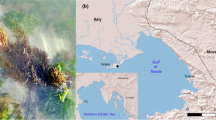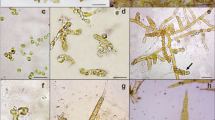Abstract
To examine optimal growth conditions of the edible green alga Caulerpa okamurae, thalli of this species were cut into erect frond (3 cm long) and stolon (5 cm long) fragments. They were cultured in combinations of four temperatures (15, 20, 25, and 30 °C), three irradiances (20, 40, and 80 μmol photons m−2 s−1), four daylengths (8, 12, 16, and 24 h), and seven salinities (15, 20, 25, 30, 35, 40, and 45 psu). After 12 days, maximal relative growth rates (RGRs) for erect fronds (6.78% day−1) and stolons (7.02% day−1) occurred at 25 °C and 40 μmol photons m−2 s−1. At 30 °C, growth differences were found; negative growth for erect fronds and positive growth for stolons, with an average RGR of 1.96% day−1. A daylength of 16 h and salinity of 30 psu were needed for maximal growth of erect fronds and stolons. Stolon exhibited a greater tolerance to high and low temperatures and low salinity than erect fronds. Thalli weight of C. okamurae was increased by increments of stolon length, new erect fronds, and new ramuli. In conclusion, C. okamurae should be cultivated in summer with high seawater temperature (25 °C) and long daylength, in waters of 30 psu, and at a water depth providing 40 μmol photons m−2 s−1. These physiological and growth pattern data are informative for the successful development of commercial cultivation of C. okamurae.




Similar content being viewed by others
References
Bischoff B, Wiencke C (1993) Temperature requirements for growth and survival of macroalgae from Disko Island (Greenland). Helgoländer Meeresun 47:167–191
Choi HG (1996) Life history and temperature and light responses in growth and reproduction of Caulacanthus okamurai (Gigartinales, Rhodophyta) in Korea. Dissertation, University of Pukyong
Choi CG, Hwang EK, Sohn CH (2000) Culture studies on the green alga, Caulerpa okamurae І. growth and regeneration. J Aquacult 13:253–258 (in Korean with English abstract)
Choi HG, Lee KH, Yoo HI, Kang PJ, Kim YS, Nam KW (2008) Physiological differences in the growth of Sargassum horneri between the germling and adult stages. J Appl Phycol 20:729–735
Collado-Vides L, Robledo D (1999) Morphology and photosynthesis of Caulerpa (Chlorophyta) in relation to growth form. J Phycol 35:325–330
de Gaillande C, Payri C, Remoissenet G, Zubia M (2017) Caulerpa consumption, nutritional value and farming in the Indo-Pacific region. J Appl Phycol 29:2249–2266
Deraxbudsarakom S, Songsangjinda P, Chiayvareesajja S, Tuntichodok P, Pariyawathee S (2003) Optimum condition of environmental factors for growth of sea grape (Caulerpa lentillifera: J. Agardh). Warasan Kanpramong (Thai Fisheries Gazette), AGRIS records, http://agris.fao.org/aos/records/TH2005000960
Flagella MM, Lorenti M, Buia MC (2008) Temperature response in a shallow-water Mediterranean population of Caulerpa racemosa var. cylindracea (Caulerpales, Chlorophyta), and a possible strategy of season anticipation. Bot Mar 51:278–284
Friedlander M, Kosov Y, Keret G, Dawes C (2006) Production of rhizoids by Caulerpa prolifera in culture. Aquat Bot 85:263–266
Friedman GM (1968) Geology and geochemistry of reefs, carbonate sediments, and waters, Gulf of Aqaba (Elat), Red Sea. J Sediment Res 38:895–919
Gao X, Endo H, Nagaki M, Agatsuma Y (2017) Interactive effects of nutrient availability and temperature on growth and survival of different size classes of Saccharina japonica (Laminariales, Phaeophyceae). Phycologia 56:253–260
Gennaro P, Piazzi L, Persia E, Porrello S (2015) Nutrient exploitation and competition strategies of the invasive seaweed Caulerpa cylindracea. Eur J Phycol 50:384–394
Guo H, Yao JT, Sun ZM, Duan DL (2015a) Effect of temperature, irradiance on the growth of the green alga Caulerpa lentillifera (Bryopsidophyceae, Chlorophyta). J Appl Phycol 27:879–885
Guo H, Yao JT, Sun ZM, Duan DL (2015b) Effect of salinity and nutrients on the growth and chlorophyll fluorescence of Caulerpa lentillifera. Chin J Oceanol Limnol 33:410–418
Hanelt D, Nultsch W (2003) Photoinhibition in seaweeds. In: Heldmaier G, Werner D (eds) Environmental signal processing and adaptation. Springer, Berlin, pp 141–167
Hori T (1994) An illustrated atlas of the life history of algae. Uchida Roukakuho Publishing, Tokyo (in Japanese)
Khou M, Paul NA, Wright JT, Steinberg PD (2007) Intrinsic factors influence the attachment of fragments of the green alga Caulerpa filiformis. J Exp Mar Biol Ecol 352:331–342
Kirst GO (1989) Salinity tolerance of eukaryotic marine algae. Annu Rev Plant Physiol 41:21–53
Komatsu T, Meinesz A, Buckles D (1997) Temperature and light responses of alga Caulerpa taxifolia introduced into the Mediterranean Sea. Mar Ecol Prog Ser 146:145–153
Komazawa I, Sakanishi Y, Tanaka J (2015) Temperature requirements for growth and maturation of the warm temperate kelp Eckloniopsis radicosa (Laminariales, Phaeophyta). Phycol Res 63:64–71
Kurashima A, Serisawa Y, Kanbayashi T, Toma T, Yokohama Y (2003) Characteristics in photosynthesis of Caulerpa lentillifera J. Agardh and C. racemosa (Forsskal) J. Agardh var. laete-virens (Montagne) Weber-van Bosse with reference to temperature and light intensity. Jpn J Phycol 51:167–171 (in Japanese with English abstract)
Lee YP (2008) Marine algae of Jeju. Academy Book Company, Seoul (in Korean)
Lüning K (1990) Seaweeds. Their environment, biogeography and ecophysiology. John Wiley, New York
Malta E, Ferreira DG, Vergara JJ, Perex-Llorens JL (2005) Nitrogen load and irradiance affect morphology, photosynthesis and growth of Caulerpa prolifera (Bryopsidales: Chlorophyta). Mar Ecol Prog Ser 298:101–114
Montefalcone M, Morri C, Parravicini V, Bianchi CN (2015) A tale of two invaders: divergent spreading kinetics of the alien green algae Caulerpa taxifolia and Caulerpa cylindracea. Biol Invasions 17:2717–2728
Morita T, Yamamoto K, Nishigaki T, Endo H, Takeno K (2013) The effect of light and temperature on the growth and morphogenesis of Caulerpa okamurae in outdoor mesocosm. Aquacult Sci 61:383–387 (in Japanese with English abstract)
Morris C, Bala S, South GR, Lako J, Lober M, Simos T (2014) Supply chain and marketing of sea grapes, Caulerpa racemosa (Forsskål) J. Agardh (Chlorophyta: Caulerpaceae) in Fiji, Samoa and Tonga. J Appl Phycol 26:783–789
Nagappan T, Vairappan CS (2014) Nutritional and bioactive properties of three edible species of green algae, genus Caulerpa (Caulerpaceae). J Appl Phycol 26:1019–1027
Paul NA, de Nys R (2008) Promise and pitfalls of locally abundant seaweeds as biofilters for integrated aquaculture. Aquaculture 281:49–55
Paul NA, Neveux N, Magnusson M, de Nys R (2014) Comparative production and nutritional value of “sea grapes”—the tropical green seaweeds Caulerpa lentillifera and C. racemosa. J Appl Phycol 26:1833–1844
Piazzi L, Meinesz A, Verlaque M, Akҫali B, Antolić B, Argyrou M, Balata D, Ballesteros E, Calvo S, Cinelli F, Cirik S, Cossu A, DʼArchino R, Dellouli AS, Javel F, Lanfranco OE, Mifsud C, Pala D, Panayotidis P, Peirano A, Pergent G, Petrocelli A, Ruitton S, Žuljević A, Ceccherelli G (2005) Invasion of Caulerpa racemosa var. cylindracea (Caulerpales, Chlorophyta) in the Mediterranean Sea: an assessment of the spread. Cryptogam Algol 26:189–202
Schaffelke B, Deane D (2005) Desiccation tolerance of the introduced marine green alga Codium fragile ssp tomentosoides—clues for likely transport vectors? Biol Invasions 7:557–565
Smith CM, Walters LJ (1999) Fragmentation as a strategy for Caulerpa species: fates of fragments and implications for management of an invasive weed. Mar Ecol 20:307–319
Sokal RR, Rohlf EJ (1995) Biometry: the principles and practices of statistics in biological research, 3rd edn. Freeman, New York
Tatewaki M (1966) Formation of a crustose sporophyte with unilocular sporangia in Scytosiphon lomentaria. Phycologia 6:62–66
Ukabi S, Dubinsky Z, Steinberger Y, Israel A (2012) Surveying Caulerpa (Chlorophyta) species along the shores of the eastern Mediterranean. Mediterr Mar Sci 13:5–11
Ukabi S, Dubinsky Z, Steinberger Y, Israel A (2013) Temperature and irradiance effects on growth and photosynthesis of Caulerpa (Chlorophyta) species from the eastern Mediterranean. Aquat Bot 104:106–110
West EJ, West RJ (2007) Growth and survival of the invasive alga, Caulerpa taxifolia, in different salinities and temperatures: implications for coastal lake management. Hydrobiologia 577:87–94
Williams SL, Grosholz ED (2002) Preliminary reports from the Caulerpa taxifolia invasion in southern California. Mar Ecol Prog Ser 233:307–310
Wright JT, Davis AR (2006) Demographic feedback between clonal growth and fragmentation in an invasive seaweed. Ecology 87:1744–1754
Yoshida T (1998) Marine algae of Japan. Uchida Roukakuho Publishing, Tokyo (in Japanese)
Acknowledgements
We would like to thank anonymous reviewers and the editor for helpful comments that improved the manuscript. This research was financially supported by a grant from the Marine Biotechnology Program funded by the Ministry of Ocean and Fisheries of the Korean Government. This work was also supported by the National Research Foundation of Korea (NRF) grant funded by the Ministry of Education, Science and Technology (NRF-2016R1A2B1013402 and NRF-2018R1A6A301012467).
Author information
Authors and Affiliations
Corresponding author
Rights and permissions
About this article
Cite this article
Gao, X., Choi, H.G., Park, S.K. et al. Assessment of optimal growth conditions for cultivation of the edible Caulerpa okamurae (Caulerpales, Chlorophyta) from Korea. J Appl Phycol 31, 1855–1862 (2019). https://doi.org/10.1007/s10811-018-1691-z
Received:
Revised:
Accepted:
Published:
Issue Date:
DOI: https://doi.org/10.1007/s10811-018-1691-z




